A recent global review has identified 57 new living species of foraminifera, tiny marine organisms known for their ecological significance. Conducted by a research team from Geomarine Research (NZ), the study highlights three new species found in New Zealand waters. The findings were published on November 14, 2025, in the journal Micropaleontology.
The research employed a combination of DNA sequencing and morphological analysis to examine foraminifera residing in seafloor sediments across coastal and shallow offshore regions. This comprehensive review includes over 200 species and represents only the second global assessment using these advanced techniques. The first study of this kind was also led by the same team and published in 2021.
The results reveal that the highest diversity of foraminifera occurs in the northwest Pacific, with 74 species identified along the coasts of China and Japan. Australia follows closely with 58 species, while Antarctica remains devoid of these families. Notably, 24 species inhabit the Arctic Ocean, underscoring the widespread nature of these organisms.
Dr. Bruce W. Hayward, a key contributor to the research, noted that the newly recognized species predominantly originate from the Southern Hemisphere, which has seen less exploration in the past 250 years. The first foraminifera species was described in the Mediterranean by Carl Linnaeus in 1758.
The geographic distribution of the new species is varied, with the largest number emerging from southern Africa (13 species), followed by Australia (9 species), and the northwest Pacific (8 species). Additionally, the study documented contributions from the Mediterranean, northern Indian Ocean, South America, New Zealand, Pacific Islands, Indonesia, the Caribbean, the Arctic Ocean, and the Black Sea.
“This new study brings the number of recognized species in these families around New Zealand up to 18,” Dr. Hayward stated. The types of the three new species from New Zealand were collected from Stewart Island, Tolaga Bay, and Waitemata Harbor, and are now preserved in the collections of the Museum of Auckland and Earth Science New Zealand.
Foraminifera are microscopic organisms, averaging about 0.4 mm in size, that thrive in vast numbers within seafloor sand and mud in estuaries, harbors, and offshore environments. Currently, there are approximately 9,000 living species globally, alongside 40,000 described extinct fossil species.
These organisms play a crucial role in understanding environmental changes. Dr. Hayward elaborated on their significance, stating, “Foraminifera are widely used to study the impacts on coastal ecosystems of pollution and sediment runoff; they document historical sea level changes and provide insights into past and present climate change.”
He emphasized the necessity of accurately identifying foraminifera to apply them effectively in various scientific studies. The research also highlights the extent of human-induced transportation of marine species, with at least 33 non-indigenous species now residing in regions far removed from their original habitats.
This study not only broadens our understanding of foraminifera diversity but also underscores their importance as indicators of environmental change. The recognition of these new species marks a significant advancement in marine biology and ecological research.
For further details, refer to the original study: Bruce W. Hayward et al, “Molecular and morphological taxonomy and biogeography of living Cribroelphidiidae, Elphidiellidae, Elphidiidae, Haynesinidae and related taxa (Foraminifera, Rotalioidea),” published in Micropaleontology in 2025.







